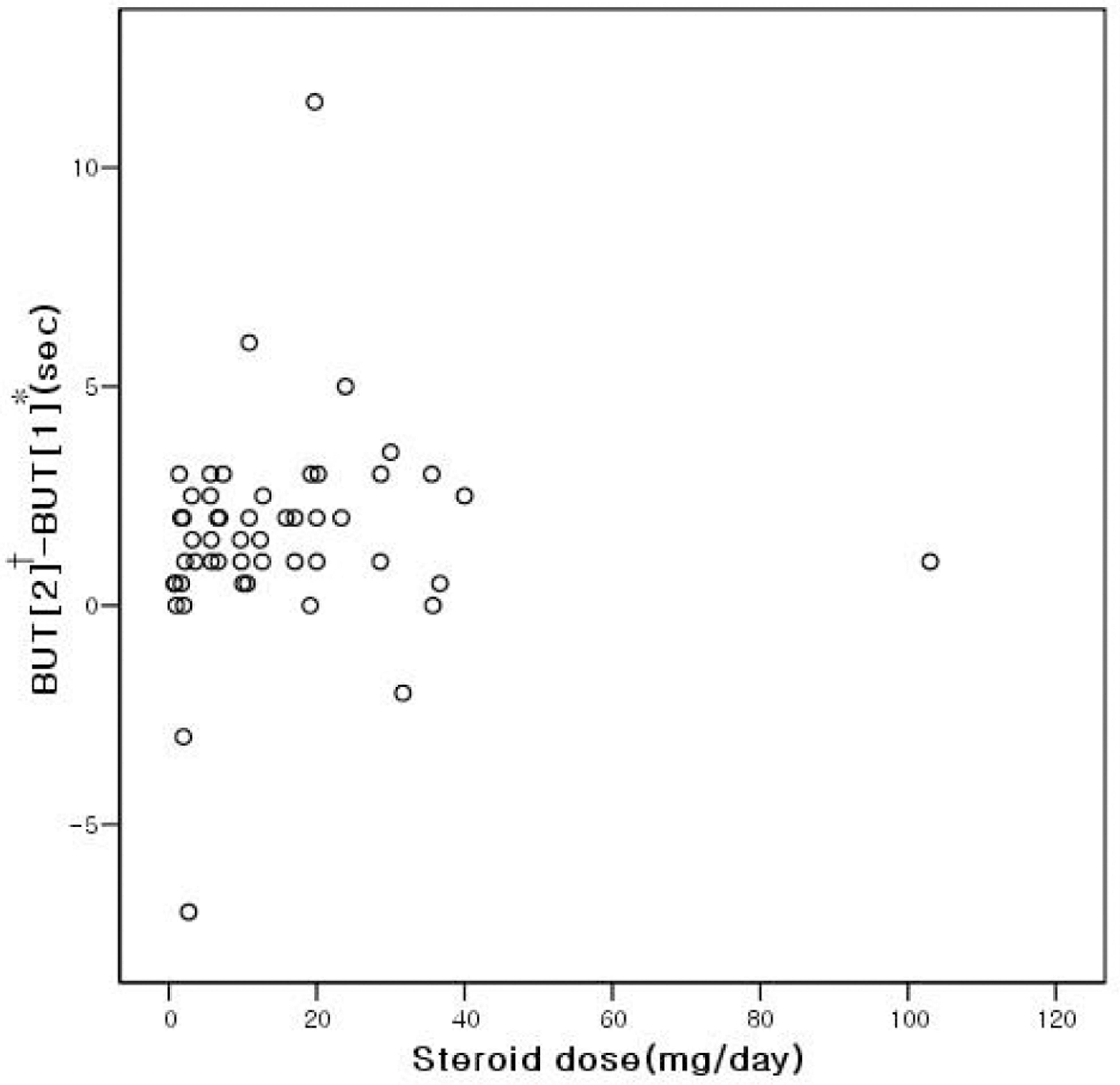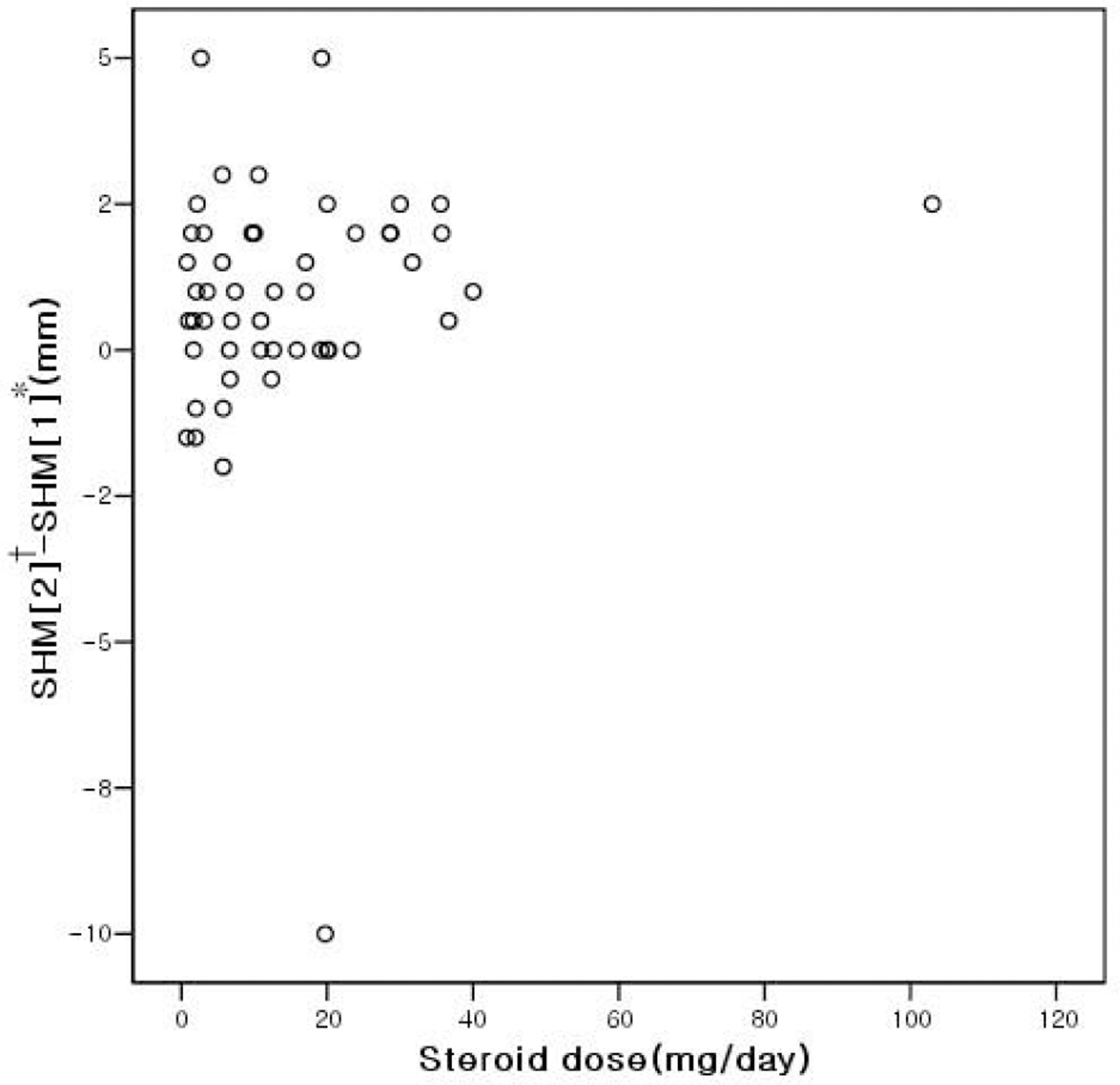Abstract
Purpose
To evaluate the effects of systemic steroid therapy on the development of dry eye syndrome (DES) in graft-versus-host disease (GVHD) resulting from hematopoietic stem cell transplantation (HSCT) in hematologic malignancy (HM) patients.
Methods
We analyzed 108 HSCT patients. We measured tear film break‐ up time (BUT) and basal tear secretion, and checked for corneal lesions. BUT under 10 seconds and basal tear secretion under 10 mm gave a diagnosis of DES. Significant corneal lesions were also described in this gorup. We compared the clinical aspect and frequency of dry eye according to GVHD and also compared clinical aspects of dry eye in GVHD patients before and after systemic steroid therapy.
Results
Fifty-six patients (51.9%) developed GVHD, including 51 patients (91.1%) in the GVHD group and 31 patients (59.6%) in the non-GVHD group. The frequency of DES was statistically significant in the GVHD group ( p<0.05). BUT and basal tear secretions were 4.08±1.76 sec and 6.05±2.57 mm in the GVHD group and 5.37±1.83 sec and 7.08±1.54 mm. There were 32 peoples (57.1%) with corneal lesions in the GVHD group and 13 peoples (25.0%) in the non-GVHD group. Based on these results, DES was statistically significant in the GVHD group. In the GVHD group, BUT and basal tear secretion levels were 4.08±1.76 sec and 6.05±2.57 mm before systemic steroid therapy and 5.20±2.91 sec and 6.73±1.80 mm after the therapy. The difference was statistically significant ( p<0.05), so we concluded that systemic steroid therapy relieved DES. Before steroid therapy, 32 peoples (57.1%) had corneal lesions, and this number decreased to 25 peoples (44.6%) after steroid therapy. The difference was not statistically significant, but we presumed that steroid therapy improved the corneal lesions ( p>0.05).
References
1. Ferrara JL, Deeg HJ. Graft‐ versus‐ host disease. N Engl J Med. 1991; 324:667–74.
2. Atkinson K. Chronic graft‐ versus‐ host disease. Bone Marrow Transplant. 1990; 5:69–82.
3. Gratwhol AA, Moutsopoulos H, Chused TM. . Sjögren‐ type syndrome after allogeneic bone‐ marrow transplantation. Ann Intern Med. 1977; 87:703–6.
4. Calissendorff B, Azazi ME, Lönnqvist B. Dry eye syndrome in long‐ term follow-up o bone marrow transplanted patients. Bone Marrow Transplant. 1989; 4:675–8.
5. Lelli GJ Jr, Musch DC, Gupta A. . Ophthalmic cyclosporine use in ocular GVHD. Cornea. 2006; 25:635–638.

6. Ogawa Y, Okamoto S, Mori T. . Autologous serum eye drops for the treatment of severe dry eye in patients with chronic graft‐ versus‐ host disease. Bone Marrow Transplant. 2003; 31:579–83.
7. Murphy PT, Sivakumaran M, Fahy G, Hutchinson RM. Successful use of topical retinoic acid in severe dry eye due to chronic graft‐ versus‐ host disease. Bone Marrow Transplant. 1996; 18:641–642.
8. West RH, Szer J, Pedersen JS. Ocular surface and lacrimal disturbances in chronic graft‐ versus‐ host disease: the role of conjunctival biopsy. Aust N Z J Ophthalmol. 1991; 19:187–91.
9. Behrens A, Doyle JJ, Stern L. . Dysfunctional tear syndrome: a Delphi approach to treatment recommendations. Cornea. 2006; 25:900–7.
10. Hauch M, Gazzola MV, Small T. . Anti‐ leukemia potential of Interleukin‐2 activated natural killer cells after bone marrow transplantation for chronic myelogenous leukemia. Blood. 1990; 75:2240–62.
11. Pak KH, Myong YW, Rhee SW. A clinical evaluation of ocular manifestation in bone marrow transplanted patients. J Korean Ophthalmol Soc. 1991; 32:294–9.
12. Ogawa Y, Yamazaki K, Kuwana M. . A significant role of stromal fibroblast in rapidly progressive dry eye in patients with chronic GVHD. Invest Ophthalmol Vis Sci. 2001; 42:111–9.
13. Ogawa Y, Okamoto S, Kuwana M. . Successful treatment of dry eye in two patients with chronic graft-versus-host disease with systemic administration of FK506 and corticosteroids. Cornea. 2001; 20:430–4.

14. Ahmad SM, Stegman Z, Fructhman S, Asbell PA. Successful treatment of acute ocular graft‐ versus‐ host disease with tacrolimus (FK506). Cornea. 2002; 21:432–3.
15. Jack MK, Hicks JD. Ocular complications in high-dose chemoradiotherapy and marrow transplantation. Ann Ophthalmol. 1981; 13:709–11.
16. Franklin RM, Kenyon KR, Tutschka PJ. . Ocular manifestations of graft‐ vs‐ host disease. Ophthalmology. 1983; 90:4–13.
17. Heath JD, Acheson JF, Schulenburg WE. Penetrating keratoplasty in severe ocular graft versus host disease. Br J Ophthalmol. 1993; 77:525–6.

18. Kee CW, Roh KK, Lee JH. The significance of the tear film break‐ up time (BUT) in the diagnosis of the dry eye syndrome. J Korean Ophthalmol Soc. 1985; 26:1131–5.
19. Cho BJ, Lee JH, Shim OJ. . The relation between clinical manifestation of dry eye patients and their BUTs. J Korean Ophthalmol Soc. 1992; 33:297–302.
Figure 1.
Scatter graph illustrating of tear break-up time difference after systemic steroid therapy in dry eye patients of GVHD group (51 patients) (r=0.103, p=0.472); * BUT[1] † BUT[2] = = tear break-up time before steroid treatment; tear break-up time after steroid treatment.

Figure 2.
Scatter graph illustrating of basal tear secretion difference after systemic steroid therapy in dry eye patients of GVHD group (51 patients) (r=0.142, p=0.322); * SHM[1] † SHM[2] = = basal tear secretion before steroid treatment; basal tear secretion after steroid treatment.

Table 1.
Patient distribution of gender, age, GVHD, method of stem cell transplantation, dry eye
| Gender (male:female) | Age (years) | GVHD* (present:absent) | HSCT†(ABMT‡:APBSC§) | Dry eye (present:absent) |
|---|---|---|---|---|
| 61:47 (56.5%:43.5%) | 39.3±13.5 (13~66) | ) 56:52 (51.9%:48.1%) | 98:10 (90.7%:9.3%) | 82:26 (75.9%:24.1%) |
Table 2.
Distribution of hematologic malignant disease according to the existence of GVHD
|
Disease |
||||||||
|---|---|---|---|---|---|---|---|---|
| ALL† | AML‡ | CML§ | MDS∏ | MM# | POEMS Syn** | SAA†† | Total | |
| GVHD* group | 21 | 19 | 2 | 11 | 2 | 0 | 1 | 56 (51.9%) |
| Non-GVHD* group | 15 | 19 | 6 | 5 | 6 | 1 | 0 | 52 (48.1%) |
| Total | 36 | 38 | 8 | 16 | 8 | 1 | 1 | 108 |
Table 3.
Distribution of dry eye patients according to existence of GVHD*
| Group | Dry eye patients | Non-dry eye patients | Total |
|---|---|---|---|
| GVHD* group | 51 (91.1%) | 5 (8.9%) | 56 |
| Non-GVHD* group | 31 (59.6%) | 21 (40.4%) | 52 |
| p-value | p<0.05 |
Table 4.
Comparison of tear break-up time, basal tear secretion and corneal lesion in GVHD* group and non-GVHD group
| Tear break-up time (seconds) | Basal tear secretion (mm) | Corneal lesion (patients) | |
| GVHD* group | 4.08±1.76 | 6.05±2.57 | 32 (57.1%) |
| Non-GVHD* group | 5.37±1.83 | 7.08±1.54 | 13 (25.0%) |
| p-value | p<0.05 | p<0.05 | p<0.05 |
Table 5.
Comparison of tear break-up time, basal tear secretion and corneal lesion in GVHD group before and after systemi steroid therapy




 PDF
PDF ePub
ePub Citation
Citation Print
Print


 XML Download
XML Download